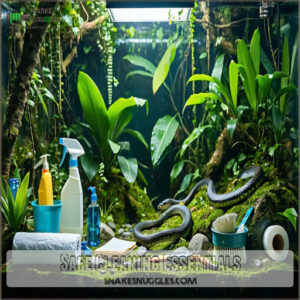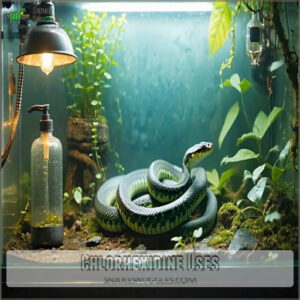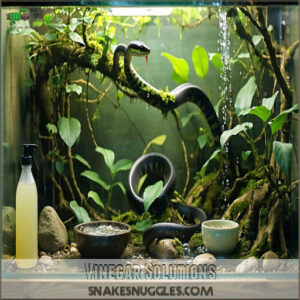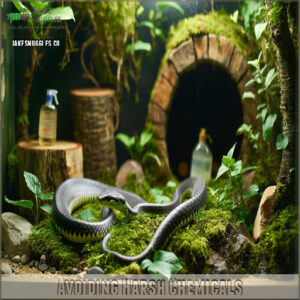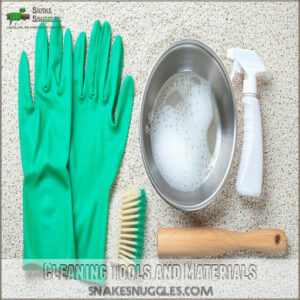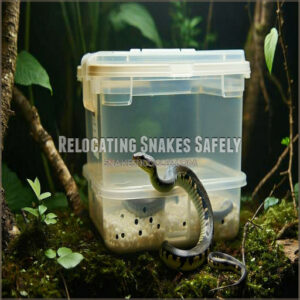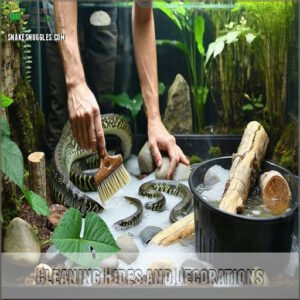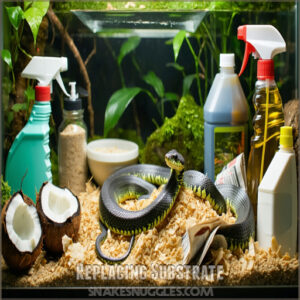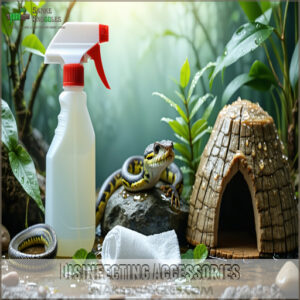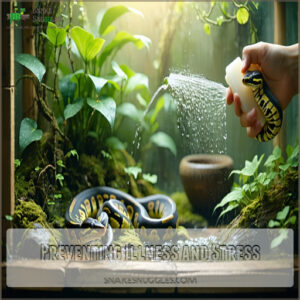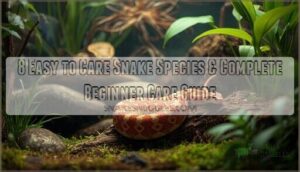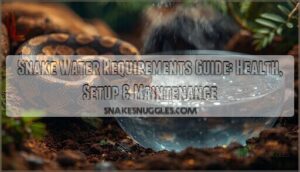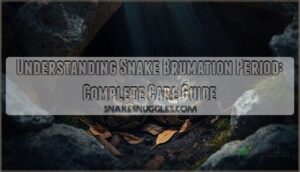This site is supported by our readers. We may earn a commission, at no cost to you, if you purchase through links.
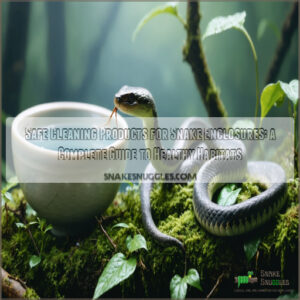 Keeping snake enclosures clean is key to a healthy pet.
Keeping snake enclosures clean is key to a healthy pet.
For safe cleaning, use products like a 50/50 vinegar-water mix—cheap, natural, and effective—or reptile-safe disinfectants such as F10SC or diluted chlorhexidine, trusted by vets.
Baking soda works wonders for deodorizing, and antibacterial dish soap paired with hot water is great for scrubbing water bowls.
Avoid harsh chemicals like bleach, which can harm your snake.
Rubber gloves, scrubbing brushes, and paper towels make cleaning easier and safer.
Regular upkeep prevents bacteria buildup and stress, helping your snake thrive.
Curious about pro-level cleaning hacks? Stick around for the finer details!
Table Of Contents
- Key Takeaways
- Safe Cleaning Essentials
- Reptile Friendly Disinfectants
- Cleaning Tools and Materials
- Deep Cleaning Techniques
- Preventing Illness and Stress
- Frequently Asked Questions (FAQs)
- What cleaning products are safe for snakes?
- What should I clean my snakes tank with?
- What is a safe antiseptic for reptiles?
- What not to put in a snake enclosure?
- Can I use essential oils for cleaning?
- How do I clean the enclosure sealant?
- Are steam cleaners safe for snake tanks?
- How often should decorations be replaced?
- What substrates are easiest to clean and sanitize?
- Conclusion
Key Takeaways
- Use products like F10SC, diluted chlorhexidine, or a 50/50 vinegar-water mix to safely disinfect without harming your snake.
- Avoid harsh cleaners like bleach, ammonia, and scented products that release harmful fumes.
- Wash water bowls daily with hot water and mild antibacterial soap, and rinse thoroughly to prevent bacteria growth.
- Spot clean waste daily and deep clean every few weeks using reptile-safe disinfectants and fresh substrate.
Safe Cleaning Essentials
You’ll need the right tools and cleaning products to keep your snake’s habitat spotless and healthy, just like maintaining a tiny jungle paradise.
Your cleaning toolkit should include reptile-safe disinfectants, rubber gloves, scrubbing brushes, and paper towels to make sure your scaly friend stays happy in their clean home.
Daily Removal of Waste
Every successful snake owner knows that daily waste management is key for a healthy habitat.
You’ll need to remove feces and urates promptly, along with any soiled substrate, to prevent bacteria buildup.
Keep a small cleaning kit nearby for quick daily sanitizing – it’s like giving your snake’s home a mini spa treatment!
Spot clean throughout the day, focusing on visible waste and maintaining a pristine environment to ensure your snake’s health, which is crucial for a healthy habitat.
Cleaning Water Bowls
Maintaining pristine water bowl sanitation stands as your snake’s lifeline to health and hydration.
You’ll need to tackle this daily bowl cleaning task with the right approach and tools.
- Use hot water and mild dish soap for thorough water bowl disinfection
- Replace fresh water daily to prevent harmful bacteria growth
- Scrub away calcium deposits with a designated snake bowl brush
- Keep a spare bowl handy for quick daily bowl refresh cycles
Regular cleaning is critical for preventing water quality issues that can harm your snake’s overall health.
Disinfecting Surfaces
Now that your water bowls are spotless, let’s tackle those enclosure surfaces.
You’ll want to use reptile-safe disinfectants like F10SC or diluted chlorhexidine for effective germ removal.
Wipe down glass walls and décor with surface sanitizers, making sure to reach those tricky corners where bacteria love to hide.
Don’t forget to let sterilized areas dry completely before returning your scaly friend to their sparkly-clean home.
Maintaining Hydration Stations
Your snake’s hydration station needs daily attention to keep it pristine. Check and clean water bowls each morning using reptile-safe disinfectants, and wipe down any condensation build-up around humidity zones.
You’ll want to monitor water quality throughout the day, especially in warmer months.
For thorough snake enclosure cleaning, scrub water bowls with warm, soapy water and rinse completely before refilling to maintain a healthy environment.
Reptile Friendly Disinfectants
You’ll need the right disinfectants to keep your snake’s home clean without putting your scaly friend at risk.
While common household cleaners can harm your reptile, specially formulated products like chlorhexidine and F10SC offer safe and effective solutions for maintaining a healthy habitat, with F10SC being a key component.
Chlorhexidine Uses
When it’s time to keep your scaly friend’s home spotless, chlorhexidine is your trusted ally.
You’ll find this powerhouse disinfectant in veterinary hospitals and zoos worldwide because it’s both effective and gentle.
It works by binding to bacterial cell membranes, stopping reproduction in its tracks.
Unlike harsh cleaners that produce dangerous fumes, chlorhexidine keeps your reptile safe while tackling tough bacteria like E. coli and Staphylococcus.
For effective disinfectant solutions, always follow the recommended dilution ratios to make sure a healthy environment.
F10SC Benefits
Veterinary-grade F10SC stands as your go-to biodegradable disinfectant for pristine snake habitats.
This gentle cleaner offers broad-spectrum protection against bacteria, fungi, and viruses while remaining completely non-toxic to your scaly friend.
You’ll find this reptile-safe disinfectant in leading veterinary hospitals and zoos worldwide.
It’s perfect for every surface in your snake’s home, from water bowls to climbing branches, and can even tackle airborne microbes.
For effective disinfection, always follow the recommended disinfection procedures to maintain a healthy environment.
Vinegar Solutions
A natural alternative to commercial cleaners, vinegar offers a cost-effective solution for your snake enclosure cleaning needs.
When properly diluted with water in a 50/50 ratio, this acid cleaning champion tackles common maintenance tasks effectively.
- Create a vinegar spray by mixing equal parts water and white vinegar
- Use the diluted solution to remove stubborn water stains from glass
- Apply this non-toxic cleaner to sanitize food and water dishes
- Let the natural disinfectant work for 5-10 minutes before rinsing thoroughly
Avoiding Harsh Chemicals
Consistently choosing safe disinfectants for your snake’s habitat means avoiding harsh chemicals that could harm your pet.
You’ll want to steer clear of these common hazards:
| Chemical | Danger | Safe Alternative |
|---|---|---|
| Bleach | Fumes persist, irritates tissues | F10SC disinfectant |
| Ammonia | Respiratory distress | Chlorhexidine |
| Pine/Cedar Oil | Toxic to reptiles | Natural vinegar solution |
Remember, eco-friendly and reptile-safe products aren’t just better for your snake—they’re gentler on the environment too, making them a good choice for harsh chemical avoidance.
Cleaning Tools and Materials
You’ll need specific tools and materials to keep your snake’s enclosure spotless and safe for your scaly friend.
From rubber gloves that protect your hands to specialized brushes that reach every corner, having the right cleaning equipment makes maintaining your snake’s habitat as easy as changing the sheets on your bed, with the key being to have the right equipment.
Rubber Gloves Importance
While handling cleaning chemicals and snake waste, rubber gloves are your first line of defense against harmful bacteria and skin irritation.
You’ll want to choose thick, durable gloves made from nitrile or latex-free materials – they’re essential protective equipment when disinfecting with reptile-safe cleaners.
Don’t skip this essential hand protection step, as it guards against both chemical exposure and potential salmonella transmission from waste handling.
The use of proper rubber cleaning gloves is important for maintaining a clean and safe environment and is a crucial step in ensuring proper hand protection.
Sponges and Scrubbing Brushes
Choosing the right sponge materials and brush types for your snake’s enclosure can make cleaning a breeze.
You’ll want dedicated cleaning tools that won’t scratch surfaces or harbor harmful bacteria.
- Keep separate sponges for different cleaning zones – one for the water area, another for general surfaces
- Use soft-bristled scrubbing brushes for stubborn spots around basking areas
- Select cleaning pads with antimicrobial properties specifically designed for reptile habitats
Regular cleaning helps prevent bacterial growth issues and maintains a healthy environment for your pet snake, which is crucial for preventing bacterial growth.
Paper Towels Uses
Why are paper towels your snake enclosure’s best cleaning companion? They’re essential for quick spill cleanup and drying surfaces after disinfecting.
You’ll find them invaluable for absorbing odors from fresh waste spots and wiping down glass walls. During reptile enclosure cleaning, keep a roll handy for emergency cleanups.
They’re perfect for snake enclosure maintenance – just remember to dispose of used towels promptly to prevent bacteria growth. This practice ensures a clean and healthy environment, making paper towels a crucial tool, and thus, your best cleaning companion.
Antibacterial Dish Soap
While paper towels handle the dry work, you’ll need a reliable antibacterial dish soap for wet cleaning tasks.
Gentle cleaners like Dawn are perfect for your snake’s habitat.
Here’s what makes dish soap a smart choice:
- Non-toxic when properly diluted
- Effectively breaks down organic waste
- Rinses completely without leaving residue
- Safe for all enclosure surfaces
- Removes stubborn grime without harsh chemicals
Just remember: less is more when mixing your soap solution.
For best cleaning results, consider using antibacterial soap to maintain a healthy environment and ensure you’re using the right tools for the job, with a reliable cleaning method.
Deep Cleaning Techniques
You’ll need to give your snake’s home a thorough cleaning every few weeks to prevent harmful bacteria from building up.
While your scaly friend enjoys a brief vacation in a temporary enclosure, you can transform their habitat into a squeaky-clean paradise using reptile-safe products and proper techniques, which will help prevent harmful bacteria from building up.
Relocating Snakes Safely
When it’s time for deep cleaning, safely moving your snake requires careful planning and the right temporary housing.
You’ll want to create a secure and comfortable space that keeps your serpentine friend calm during the cleaning process.
To achieve a stress-free relocation, understanding safe removal methods is important for maintaining a healthy environment.
| Relocation Step | Safety Tip |
|---|---|
| Prepare Housing | Use plastic container with air holes |
| Temperature | Match vivarium settings |
| Duration | Keep cleaning under 2 hours |
| Lighting | Maintain normal light cycle |
| Monitoring | Check every 15 minutes |
Cleaning Hides and Decorations
Along with your snake’s hideouts and decor, thorough cleaning is essential for a healthy habitat.
When sanitizing hides and decorations, use reptile-safe disinfectants to eliminate harmful bacteria while preserving your pet’s safety.
- Give those cozy caves a spa day by soaking them in warm, soapy water
- Scrub every nook and cranny like you’re uncovering hidden treasure
- Let each piece air-dry completely before returning it to your scaly friend’s home
Additional cleaning steps make snake enclosure cleanliness a breeze, and following these tips will help create a healthy habitat for your pet, ensuring a safe environment.
Replacing Substrate
Your snake’s substrate serves as its foundation for comfort and cleanliness.
During deep cleaning, remove all bedding materials completely and dispose of them safely. If you’re using tank liners, inspect them for wear before adding fresh substrate.
Choose from reptile-safe products like coconut husk, aspen shavings, or newspaper. Remember to match your disposable substrate choice with your snake’s natural habitat preferences and humidity needs to ensure the best environment for your pet, considering its natural habitat.
Disinfecting Accessories
After replacing the substrate, it’s time to focus on disinfecting accessories.
Use reptile-safe cleaners or disinfectant wipes for hides, rocks, and décor. A thorough scrub with cleaning solutions achieves proper germ removal.
Follow sanitize protocols by rinsing thoroughly and letting everything air-dry.
Remember, keeping snake enclosure cleaning thorough with reptilesafe disinfectants helps maintain a hygienic habitat and prevents bacterial buildup.
Preventing Illness and Stress
Keeping your snake’s habitat clean isn’t just about appearance—it prevents bacteria buildup and keeps your pet healthy.
By reducing stress and maintaining proper humidity, you create a safer, calmer environment where your snake can thrive.
Reducing Bacteria Buildup
Bacteria control begins with daily spot cleaning and well-planned cleaning schedules.
Use reptile-safe disinfectants and proven sanitizing methods like F10SC or diluted vinegar to sanitize surfaces effectively.
Avoid harsh cleaners and prioritize gentle hygiene practices.
Regularly cleaning snake enclosure cleaners—water bowls, hides, and accessories—prevents bacterial build-up.
Cleanliness isn’t just maintenance; it’s the foundation of a healthy, thriving habitat with reptile-safe disinfectants.
Maintaining Proper Humidity
Proper humidity control keeps your snake happy and healthy.
Too dry? It affects shedding. Too moist? Bacteria thrive!
Focus on moisture management with consistent water quality, ventilation systems, and temperature regulation.
Use reptile-safe products to clean and prevent mold in the enclosure.
Balance humidity daily, because a well-maintained habitat means fewer issues and a comfortable environment for your snake.
Early Detection of Health Issues
Spotting snake health issues early can save their life.
Regular health checks and monitoring help identify warning signs like lethargy, odd behavior, or uneven scales—possible illness signs like respiratory infection or scale rot.
Disease prevention starts with a clean home, using reptile safe products.
If in doubt, consult a vet promptly, as your snake’s health is in your hands, and early action can prevent issues like scale rot.
Creating a Stress-Free Environment
A calming environment is key to stress reduction.
Snakes thrive when their enclosures feel secure, clean, and consistent. Use non-toxic cleaners and reptile-safe disinfectants to maintain a healthy, odor-free space.
Focus on humidity management and proper environmental control, as sudden changes can disrupt snake behavior.
Regular snake enclosure cleaning maintains a stress-free habitat where your reptile feels safe and relaxed. By mimicking a snake friendly environment, you can create an ideal space for your pet snake to live happily.
Frequently Asked Questions (FAQs)
What cleaning products are safe for snakes?
Did you know some disinfectants kill 9% of germs but harm snakes?
Stick to safe options like F10SC, diluted chlorhexidine, or vinegar with water.
Avoid scented cleaners, bleach fumes, or phenols—they’re a snake’s kryptonite!
What should I clean my snakes tank with?
Clean your snake’s tank with hot water, mild dish soap (like Dawn), or reptile-safe disinfectants such as F10SC or chlorhexidine.
Avoid harsh chemicals like bleach or ammonia.
Rinse thoroughly and let everything air-dry completely, using reptile-safe disinfectants to ensure a clean environment.
What is a safe antiseptic for reptiles?
Chlorhexidine offers a safe and effective antiseptic for reptiles.
It’s kind to their sensitive skin, fights bacteria and fungi, and is widely trusted in veterinary care.
Think of it as a snake enclosure first-aid kit essential!
What not to put in a snake enclosure?
Skip cedar, pine, or scented substrates—they’re like kryptonite for snakes.
Avoid heated rocks, sharp décor, or sticky tape.
Never use ammonia-based cleaners, bleach fumes, or unsafe objects that could scratch, trap, or injure your snake.
Can I use essential oils for cleaning?
You shouldn’t use essential oils for cleaning snake enclosures.
Their intense scents and chemical compounds can harm your snake’s respiratory system.
Stick with reptile-safe disinfectants like chlorhexidine or diluted vinegar for a safe, snake-friendly clean.
How do I clean the enclosure sealant?
Tackle enclosure sealant with diluted vinegar or reptile-safe disinfectant, using a toothbrush for stubborn grime.
Rinse thoroughly and air-dry—it’s like giving the sealant a spa day!
Avoid harsh chemicals that could harm your snake.
Are steam cleaners safe for snake tanks?
Steam cleaners can be safe for snake tanks if you use only water without chemicals.
Avoid excessive heat near plastic parts, and let everything dry completely.
Just think of it as a deep clean without chemicals!
How often should decorations be replaced?
Switch out decorations every few months or when they show signs of wear, damage, or excessive grime.
Keeping things fresh as well prevents bacterial buildup and gives your snake’s space a little makeover!
What substrates are easiest to clean and sanitize?
Paper towels, reptile carpet, and aspen shavings are your best bets for easy cleaning.
They’re simple to spot-clean, replace, or sanitize.
Avoid loose substrates like sand—it’s messy, tough to clean, and risks causing impaction.
Conclusion
Think of your snake’s enclosure as its personal spa—it thrives when it’s clean, safe, and stress-free.
Using safe cleaning products for snake enclosures, like diluted vinegar, chlorhexidine, or F10SC, maintain a healthy environment.
Don’t skip proper scrubbing tools and regular substrate changes to keep bacteria at bay.
Avoid harsh chemicals like bleach to protect your pet.
A clean, well-maintained habitat reduces stress and illness, letting your snake live happily and you enjoy worry-free reptile care.
- https://oxyfresh.com/blogs/pet-health/snake-terrariums-101-your-guide-to-safe-cleaners
- https://www.reddit.com/r/reptiles/comments/423cc8/reptilesafe_cleaning_products/
- https://infinitescalesinfo.com/top-household-products-to-clean-ball-python-cage/
- https://aminoapps.com/c/reptiles/page/item/how-to-clean-your-snake-enclosure/WJdV_d3rIVIL0gVNXN374Ra885WlveZEd6w
- https://www.merckvetmanual.com/toxicology/household-hazards/chlorine-bleaches

